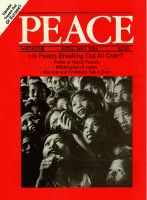
Peace Magazine Apr-May 1989, page 11. Some rights reserved.
Search for other articles by Colleen O'Manique here
In the early 1980s South Africa entered into security agreements with neighboring Angola, and Mozambique. The "Nkomati Accord" of 1984 between South Africa and Mozambique stipulated that South Africa would discontinue support for the Mozambican National Resistance (MNR), a group of bandits that make the Nicaraguan contras look like pussycats. In return, Mozambique promised to stop supporting the African National Congress (ANC).
The "Lusaka Agreement" between Angola and South Africa was signed in the same year. It stipulated that South African Defence troops would be withdrawn from Angola in return for an end to the activities of South West Africa People's Organization (SWAPO), a leftist group in Namibia that is fighting to oust South Africa from its illegal occupation of their country. Both countries were bullied into signing agreements with South Africa; both economies were in such a shambles that even a minimum chance of peace was worth grasping. Of course, neither of these agreements stopped South African terror in Mozambique or Angola.
Until the mid-1970s, Southern Africa was a relatively stable area. With the demise of colonialism came the first challenges to South Africa's hegemony, increased international attention on the region, and both economic and diplomatic pressure on the white racist regime. South Africa's new objective became the creation of a "constellation of South African states." Its goals were to keep neighboring states from becoming economically less dependent on South Africa; to "neutralize" the condemnation of apartheid; and to limit the Soviet and Cuban presence in the area by blaming Southern African problems on a "communist threat." To achieve these goals, economic aid and "disincentive tactics" (economic and military destabilization) were used. Destabilization was stepped up in the early 1980s.
The results? A recent study conservatively estimates the costs of South African destabilization on its six neighboring states as $35 billion since 1980. This does not include unquantifiable costs, such as lost tourism or forgone investment. In Mozambique, the MNR continues its rampage, destroying villages, schools, clinics, shops, and railways--and raping, torturing, and murdering the population. A largely war-induced famine has left half the rural children under five gravely malnourished.
In Angola, destabilization has been different. The Popular Movement for the Liberation of Angola (MPLA), a leftist party now governing the country, fights a largely conventional war against National Union for the Total Independence of Angola (UNITA), which is supported by South Africa and, incidentally, the United States. Cuban support for the MPLA has partly balanced the South African troops. Besides supporting UNITA, South Africa has occupied parts of Southern Angola as a base to attack the SWAPO guerrillas who challenge South Africa's illegal occupation of Namibia. The estimated toll of the war in Angola: a conservative $20 billion. One of the most highly demanded "aid" items in Angola is artificial limbs for people whose legs have been blown off by South African mines. Fatalities in the two countries probably exceed one million.
The devastation in both countries have recently sent their leaders back to bargain with South Africa. Any chance of Angola's and Mozambique's providing a viable socialist alternative to South Africa has been swept away by unprecedented financial crises. Both countries have become members of the International Monetary Fund, implementing the required "austerity measures" (the violence of which is only second to the violence coming from South Africa).
The recent accord signed between South Africa and Angola stipulates that the South African Defence Force will retreat from Angola in return for a Cuban withdrawal and Angola's cessation of support for the ANC. It also includes a commitment to implement United Nations Resolution 435, which calls for South Africa to stop occupying Namibia.
By the end of June, South Africa will have withdrawn all but 1500 troops from Namibia, according to the U.N. timetable. Rumor has it that the South Africans in Namibia are hiding arms and training Namibians to use them against the future government. South Africa will continue paying their locally-recruited army, and will give these soldiers new jobs on the Namibian police force before the withdrawal.
Namibia's fisheries and mines will still be controlled by South Africa, 80,000 rich white Namibians will still dominate the economy, and Namibia's only good natural port will remain South African. Almost 100,000 exiled Namibians will return to their country, probably to face unemployment.
A new dialogue between Mozambique and Pretoria has also begun. One hopes that a joint commitment to rebuild power lines and the giant dam that were the object of MNR attacks will ensure that the MNR ceases its economic sabotage of Mozambique's infrastructure. Moreover, the MNR has lost all credibility in the West, and has become a liability for the South African government. Its costly aggression has hurt the South African economy. And morale within the South African military is waning, if the refusal of 143 white youths to do military service is any indication.
Will these recent developments bring a modicum of peace? We hope so, but history has shown the "good intentions" of the apartheid regime to be hollow. A true peace will be possible only with the demise of apartheid.
Colleen O'Manique is a Ph.D. student in Political Science.

Peace Magazine Apr-May 1989, page 11. Some rights reserved.
Search for other articles by Colleen O'Manique here